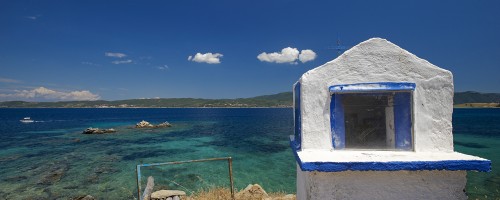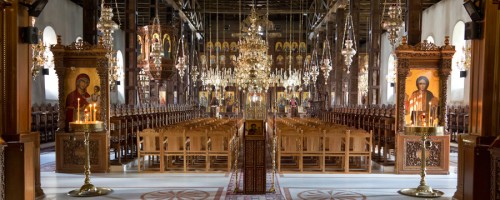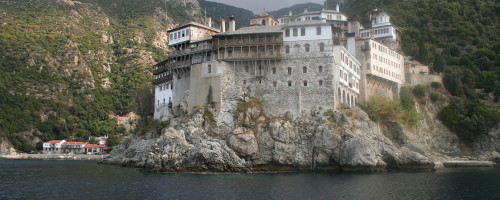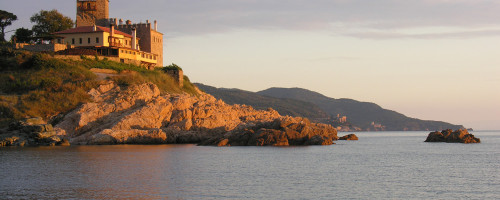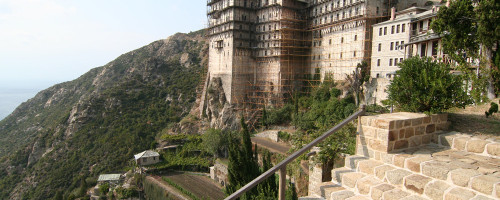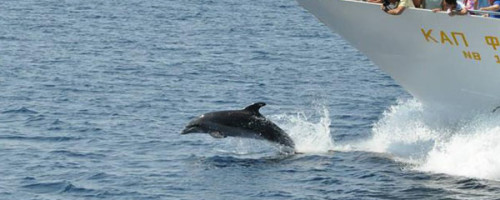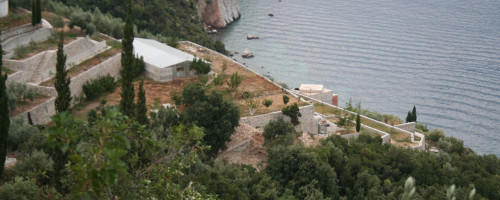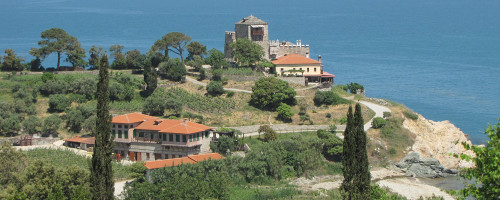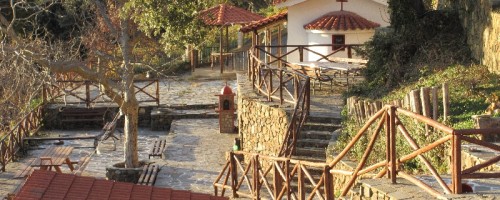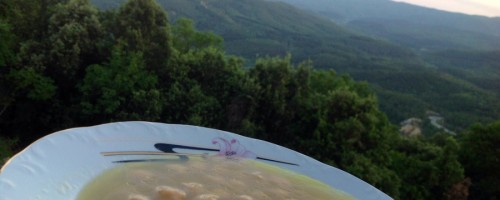
Eastern Halkidiki is the ultimate pilgrimage destination worldwide: between Mount Athos, the traditional Mantemochoria and the Aristotelian Mountain is the only Greek region that developed the religious element, which decisively «shapes» the lifestyle and phenomena throughout the range of «third leg» of Ηalkidiki. Indeed, from Arnaia to the southern tip of Mount Athos, is synthesized a number of pilgrimage routes that highlight dozens pilgrimage sites and sanctuaries – in and out of Mount Athos. These routes include extremely important pilgrimage “stations” and create countless combination ‘packages’ pilgrimage tours.
Around Mount Athos
These routes include extremely important pilgrimage «stations» and create countless combination ‘packages’ pilgrimage tours. Experience a unique religious experience visiting Mt Athos, which is a self-governed monastic state (country within a country), that automatically makes the destination a pilgrimage of world importance. The peninsula has 2.200 monks and 20 monasteries of Byzantine architecture, as well as 12 cloisters and 800 cells. Every year a million visitors marvel at the cradle of Orthodox Christianity which for over a thousand years lives under the rules of byzantine times. Mt Athos is a large museum of byzantine and post-byzantine art. Murals, rich libraries, mosaics, priceless artworks, functional utensils and relics are being kept in the monasteries and make your visit a one-of-a-kind religious experience. Around the area there are numerous religious monuments that attract annually thousands of visitors.
Visting Mount Athos
To visit Mt Athos, you have to plan in advance the exact date of entrance. Afterwards you have to contact the Office of Mt Athos Pilgrims (Egnatia 109 – Nedelkou Building – 54635 Thessaloniki, tel. +30 2310252575, fax +30 2310222424, e-mail: piligrimsbureau@c-lab.gr). You will provide the following: Name, father name, date of birth, ID or passport number, date of issue and issuing autority, and after your stay has been issued, the monasteries of your choice will be contacted with regards to your stay. You also have to contact Mt Athos Lines (tel. 0030 2377021041) to book a seat on the ship. On the day of your departure, you have to pick up your admittance of stay from the Office of Mt Athos Pilgrims in Ouranoupolis (with the showing of an ID or passport and 30 euros), and also pick up your ship ticket from Mt Athos Lines. Departure from Ouranoupolis for the port of Daphni is at 9:45 daily. The ship arrives at Daphni at around 12 noon. From there, you can take the bus to Karies, the capital of Mt Athos, and then follow your schedule by car. An alternate way is to take the ship from the port of Daphni for the southwestern part of the peninsula (Simonos Petra, Grigoriou, Dionisiou, Ag. Pavlou and skiti Ag Annis). You can also travel via small buses that belong to the Office of Mt Athos cars in Karies (tel. +30 2377023266, fax +30 2377023879). If you wish to visit directly the monasteries of the south, you can depart Ouranoupolis at 6:30, via ship Agia Anna, after you let the Mt Athos Pilgrims know in advancem so that your admittance of stay can be given to the ship’s captain, who will then give it to you.Also, pilgrims with a special admittance of stay (invitation), can only stay in the monastery which invited them. Cars and motorcycles are forbidden.
Boat Trip AROUND MOUNT ATHOS
Experience a unique religious experience visiting Mt Athos, which is a self-governed monastic state (country within a country), that automatically makes the destination a pilgrimage of world importance.The peninsula has 2.200 monks and 20 monasteries of Byzantine architecture, as well as 12 cloisters and 800 cells. Every year a million visitors marvel at the cradle of Orthodox Christianity which for over a thousand years lives under the rules of byzantine times. Mt Athos is a large museum of byzantine and post-byzantine art. Murals, rich libraries, mosaics, priceless artworks, functional utensils and relics are being kept in the monasteries and make your visit a one-of-a-kind religious experience. Around the area there are numerous religious monuments that attract anually thousands of visitors.
Riding the cruiseships Capetan Fotis & Ioanna of Athos Sea Cruises (bookings at 0030 2377071370 & 0030 2377071606), which sail away daily at 10:30 and 13:30. From the ships you will see all the monasteries of the western and southwestern peninsula, with translations in all languages. The cruise lasts 4 hours.
The pilgrimage heritage before Mount Athos
Apart from Mount Athos, in the area there are numerous of other religious monuments as well, which for the last centuries have become pilgrimage destinations, attracting every year thousands of believers: The Holy Shrine of Megali Panagia, the Monastery of Annunciation in Olympiada, the Monastery of Cosmas of Aetolia in Arnea, the Holy Cathedral of St Stephan in Arnea, the early Christian basilica at the castle of Ierissos, the Zigou Monastery in Ouranoupoli, the byzantine tower in Gomati, the Metohi of Hilandari, Zoodochos Pigi in Ierissos, the Holy Shrine of Virgin Mary the Spiliotissa in Stageira, St Nikolaos of the Mountain in the area of Stratoni, the Pammegiston Taxiarchon Church in Paleochori, the Holy Monastery of Virgin Mary, the Chara of Thlivomenon in Paleochori and so on.
Monastic Products & Jewelry, the commercial center of Ouranoupolis
While an entire pilgrimage community revolves around our local religious routes, the commercial world of Ouranoupolis moves around the promotion and distribution of monastic items, produced by the monks in the Holy Community.
The special aesthetic shops of Ouranoupolis compose a different commercial center. You will find there all the athonian production: wines and tsipouro, virgin olive oil and olives, honey and pollen, soaps and pharmaceutical creams, herbs and sweets of the spoon.
You will buy excellent icons, made by athonian hagiographers and you will see priests from the international orthodox community, procuring vestments and priestly items of unimaginable quality and aesthetics.
You will visit the jeweler’s shops to admire / buy Byzantine-inspired jewelry.
You will smell / buy aromatic frankincense.
You will also find information material for Mount Athos written in all languages.
In Ouranoupolis you will feel the aura of Mount Athos in every step!
Easter at the gate of Mount Athos, the famous Epitaph in Ouranoupolis
Easter in Ouranoupolis marks the beginning of the summer season. An atmosphere of true religious celebration and reverence, mixed with the smell of spring / sea breeze, causes an influx of visitors from Greece and European countries, flooding the local hotels.
Several months before Easter, local women prepare the elegant decoration of the Epitaph. It is a unique work of art – a tradition brought from the unforgettable homeland of Mikrasia – that is permanentized from generation to generation.
On Good Friday everybody follows the procession of the Epitaph.
On Saturday in the main square, in front the Prosforiou Tower, the resurrection of Christ event consists an impressive expression of joy and celebration!
Celebrate the Easter Holidays at Arnea!
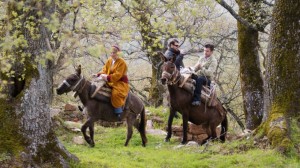 Easter at Arnea is being celebrated with a great pomp: on Good Friday the two epitaphs are processed in the paved paths and the cobblestone streets of the village, under the sounds of the Philarmonic, until the light of the Resurrection comes at the City Hall Square. The atmosphere is flooded by the scents of the candles, the incense and the spring flowers.
Easter at Arnea is being celebrated with a great pomp: on Good Friday the two epitaphs are processed in the paved paths and the cobblestone streets of the village, under the sounds of the Philarmonic, until the light of the Resurrection comes at the City Hall Square. The atmosphere is flooded by the scents of the candles, the incense and the spring flowers.
On Easter Sunday everything celebrates! At the central square the Easter Stand is set and the residents offer the visitors red eggs and pastries, wishing “Hronia Polla”!
On the morning of Easter Monday, the tradition revives under the custom of “Kantari”. People hang a large scale on the perennial tree of the central square and weigh those who weigh more kilos. It is about a very popular custom, which annually attracts many people, since for the old times, the scale was a proof for those that didn’t fast during the Lent.
On Easter Tuesday, at the chapel of Prophet Elias revives the old custom of “Koutsmanous”. The participants are dressed in traditional costumes and the horse riders with old guns, set off from the central cobbled square and head to the chapel. When they arrive, the church’s icons are being processed and then the dance “Koutsmanos” begins. Reviving this custom is being completed with shooting, having as targers red eggs. Later in the noon, participants and visitors head to the church of St. Paraskevi and the park, where they savour delicious Eastern tastes.
One other custom of Easter Tuesday is “Sousaritsa”, where the participants hold a red egg competing each other, rolling over the grass, but without breaking it.
Celebrate during our religious and local feasts
In the litanies, religious celebrations and feasts you will celebrate with the locals the rhythm of the Greek folk and worship tradition, which has the magical ability to touch the cells of every attendee, conquering the human senses. Learn more and become part of our religious tradition!
• On 18th of January, the celebration of St. Athanasios at Stanos, where a series of events take place, all related to the local tradition.
• On 9th of March, at Gomati, where is celebrated the memory of 40 Martyrs and are conducted events of religious character.
• On 25th of March the celebration of the Holy Monastery of the Annunciation at Olympiada.
• On the day of St George celebration, at Varvara, numerous traditional events, accompanied with food supply (kourmpani)
• On the same day, Neohori celebrates its patron Saint.
• On Easter Tuesday, Megali Panagia, Stageira, and Varvara celebrate the chapels of St. Raphael, when in Ierissos and Arnea celebrate the chapels of Zoodocho Pigis.
• On 2nd of May, the celebration of St Athanasios, whose events take place at the churches of Megali Panagia, Stanos (also celebrated May Day), Neohori and Varvara.
• On 20th of May, the celebration of St Nikolaos of the mountain, at Stratoni, where a great feast takes place, combined with the sense of the nature.
• On the day of Holy Spirit celebration, at Ouranoupoli take place various folklore events, which because of the holiday weekend, attract lots of visitors. On the same day, Gomati celebrates with its chapel of Holy Trinity.
• On 29th of June, Ierissos celebrates its chapel for Apostles Peter and Paul
• On July 5, Paleohori celebrates St Athanasios the Athonite, and on this occasion the residents organise various folklore events.
• On July 7, Olympiada celebrates St. Kiriaki. Numerous of events are being organised and conducted in the village during the whole previous week. Among them, the famous “Feast of Musssels”, which attracts visitors from the whole Macedonia and from European countries as well.
• On July 20, Ierissos celebrates Prohet Elias, organising a big festival a few miles outside the village. On the same day, Prophet Elias is being celebrated at Gomati and Neohori. Feasts, dance, folklore events compose the summer character of the destination, which always attract crowds of visitors!
• On July 26, at Arnea, the great and famous festival to honor the memory of St. Paraskevi. Thousands of people gather at the homonym park to attend the liturgy, to celebrate, to have fun, and dance at the sound of folklore music, which sounds all night constantly, keeping the city alive at every point.
• On July 27, Ierissos honors the memory of St. Panteleimon, organizing a big folk festival.
• On 15th of August, at Megali Panagia, takes place the biggest festival of the region. Thousands of people gather and overnight at the holy temple, forming an alive chain from people, waiting to worship the Holy icone. Later they celebrate at the squares, the streets, and the alleys of the village until the morning.
• On August 23, at Nea Roda, the residents celebrate the 9 days of Virgin Mary, and organise an overnight folk festival, usually accompanied by feasts dedicated to fish, such as “The Sardine Feast”, or “The anchovies Feast”, gathering crowds of visitors.
• The next day, on August 24, at Arnea take place events, where the residents commemorate St. Kosmas Aitolos.
• On September 1, Stanos honors the local St. Haido and organises events than last even for a week!
• On September 8, at Ierissos, Stageira, and Megali Panagia celebrate the Nativity of Virgin Mary and organise cultural and folklore events.
• On Novemebr 1, Arnea celebrates the memory of Saints Anargyroi, which coincides with the celebration of the city’s liberation by the Turks.
• On November 8, Paleohori celebrates the Great Archangels and organises celebrations.
• On December 4, Stratoni celebrates the memory of the patron saint of mining, St. Varvara, which is always accompanied by multi-days festivals and the opening of Christmas Fairy Tale Land (Paramithohora)
• On December 6, Ierissos celebrates the patron saint for its seamen and the sailors, St Nicolaos, and Stratoniki its saint patron as well.
• On December 8, Arnea and Stageira celebrate St. Modestos
Visit the chapel of Saint Nikolas on the Aristotelian Mountain
On the edge of a gorge of Stratoniki mountain just below the peaks of Argyrolofou, the church of St. Nicholas of the mountain stands. From that dominant position, it oversees a beautiful area, which is dominated by two colors, the green of the forest, almost up to the waves and the blue of the bay of Ierissos. In the horizon to the southeast, presents the rugged Athos, the Perivolaki of Panagia, with its twenty monasteries.
But, why St. Nicholas of the mountain? Will the visitor wonder. The churches of St. Nicholas were usually built near the sea, but the picture of our holy person found in the hollows of old oak, in the place where the memorable first old church, in the gorge, since then named the gorge of St. Nicholas.
According to an old inscription that was found at the scene, gives a foundation year of the old church in 1818. At the time of discovery of the icon is as follows:
A shepherd from Isvoro, as old called the Stratoniki named Theodoros Sakalis, grazing his flock across the ravine. One night he saw light being lit in the darkness of the mountain. This was repeated several times. He found the point and after investigation he found in a hollow of an old oak the picture of St. Nicholas. He immediately alerted the priest of Stratoniki, who came and received it. But the picture returned. This happened three times, until the Saint presented himself in a dream of the priest and said: “Where did you find me, my house will you make me.”
So it happened. The old church was built in a level higher than the current one. It was a single-nave basilica, a picturesque church which was loved by the local people. In central shrine the old picture is resting, full of offerings of the faithful.
The image has dimensions of 70 * 80 and depicting St. Nicholas with the priestly outfit. In the left hand he holds the bible and with his right hand he blesses. The saint occurs gaunt, with a few sparse white beard. The look is pointing to the right and does not look directly at the pilgrims.
Many are the miracles connected with the picture and the Church of St. Nicholas in general. There is no family in Stratoniki and Stratoni villages in general, but also from more distant areas, that cannot remember some beneficence or miracles, coming from the St. Nicholas of the mountain.
In 1945, a great fire burnt all the mountains up to the sea. Only the church of St. Nicholas – in Divine Will – escaped the horrific fire, when the last moment the direction of the wind changed. Remarkable is the miracle made by St. Nicholas in favour of a turk in the region before the war, which saved him when shattered in deep mountain ravines. The turk Arif baptized Nikolaos, from gratitude to the saint.
In the past, there was a spring with plenty of cool water, which in our days has unfortunately lost. Here lived the guardian of the temple. Great reputation of a virtuous person had uncle Nicholas, who for many years served the church. The two large cypress trees, on the edge of the court, marks the tombs of two children of a wealthy Italian, who died in Isvoro in early 19th century by epidemic. In modern times the two story guesthouse for pilgrims was built.
Unfortunately in the 1990s the old church of the holy was demolished and the present church took position its place in 1996, which is smaller than the old one. Locals though were tied to the old church, loved also the new, because it is the same grace of the St. Nicolas everywhere. To that church pilgrims devoutly arrive every day to worship, to request the assistance of the St. Nicolas and spend the day in a cool environment. When they leave, they feel completely different, renovated in spirit from their contact with the divine and nature.
The church of St. Nicholas of the mountain celebrates on the 20th May, the day of exhumation and transfer of his remains in ossuary.
The road in the picture below is the 15th km from Ierissos to Stavros and the arrow shows the way to the hermitage of St. Nickolaos.

